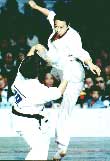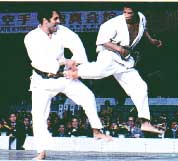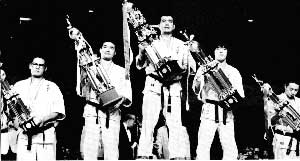|
|
Time: March 8-9, 1975
Place: Nihon - Budokan (Japan Millitary Arts Hall)
|
The First World Open Karate Tournament Officials The Judges |
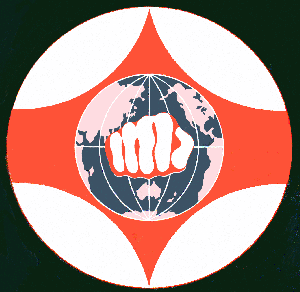 |
To: All Athletes Competition rules |
THE FIRST WORLD OPEN KARATE TOURNAMENT
From King Hussein :
Congratulations to you, Mas. Oyama, and best wishes for the sue success of your First World Open Karate Championship, which will be held under the auspices of the Kyokushintaikan International Karate Organization. Kyokushin-Karate, or Oyama-Karate, has become popular and high-ly respected all over the world. Its karate spirit is admired even more than its art. Karate spirit represents courtesy, self-discipline, respect for superiors and friendship. Kyokushin-Karate begin with courtesy and ends in courtesy. These are the basic morales required of members of all societies. Japan is well known as the "Land of Courtesy" and I believe this wonderful reputation will always remain with Japan, as long as there is the Kyokushinkaikan Karate spirit. I am truly looking toward to this Championship.

A Message From Kyokushinkaikan President, Minister of Japan Matsuhei Mori:
Mas. Oyama and I are profoundly moved and happy to announce the opening of the First World Open Karate Tournament. This World Tournament which has long been our dream, will be held here in Tokyo, March 8, 9, 1975. I am extremely impressed and pleased with the achievements and prosperity of the Kyokushinkaikan International Karate Organization. The followers of Kyokushinkaikan are well over 1,500,000 and the name "Oyama-Karate" is still growing and spreading throughout the world. Mas. Oyama is truly a "Karate Baka" or "Karate Devotee". During his inspiring lifetime he has. been able to think only of Karate. He was born in Karate, lived his life in Karate, and will die in Karate. Mas. Oyama has been able to obtain karate success and prosperity because of his great, earnest and painstaking labor. I sincerely congratulate Mas. Oyama on this World Karate Championship.

Mr. Hiroyoshi Kawada Vice President of the tournament committee President of Nikkon Sports News-Publishing Co. Ltd.
It is the greatest delight for me, as one of the tournament directors, to congratulatie Mas. Oyame on the occasion of the First World Open Karate Tournament. This championship tournament will be held in the Nihon-Budokan Hall, whose beautiful architecture is noted as symbolic of Japanese Martial Arts. Our company published the biography of Mas. Oyama, "Karate-Baka Ichidai", and we were amazed at the tremendous popularity and interest in his stormy life. The highly respected and honored nickname, "Karate-Baka" (means Karate-Devotee) is truly suitable for a man who has dedicated his entire life and enthusiasm to karate. Mas. Oyama is constantly offering all his energy arid efforts to karate. We can vividly feel his dynamic presence in our life and in our society. He is doing everything possible to assure us of a World Tournament we shall never forget. Foreign athletes from all over the world have been invited and he is supervising the Japanes athletes in long hours of serere training. His vitality frightens and overwhelms us. Recently the karate competency of foreign athletes has increased outstandingly, so we may be certain of seeing a thrilling and memorable Championship Tournament, next March, in Tokyo.
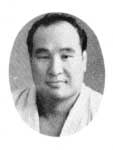
THE FIRST WORLD OPEN KARATE TOURNAMENT
International Karate-Organization Kyokushmkaikan Director Mas. Oyama.
The world today is confronted with numerous crisis that seem to be our touchstone and challenge for world unity and a world of peace. We are faced with diminishing natural resources, the unhappy and unpleasant disagreement between countries. North and South, East and West and the critical predicament of the weak, poor and hungry These conditions are universal and require that every man make a personal and serious effort to create a better world. We can do this, by self-discipline, dedication and sincere purpose-through Karate.
In the past. Karate was known usually as only one of the martial arts that consisted of powerful and mysterious fighting technics. The oriental belief, however, is that Heaven, or God, provided us with a body and physical abilities as a means for our survival and progress. The fundamental principle of karate, therefore, is the efficient utilization of these natural basic body move-ments that have always existed with us and are used everywhere and for all purposes. The technical ability and skill to use the body, hand or foot as a weapon was refined and polished - and later incorporated a spiritual discipline - and now has become known as the unarmed martial art-Karate. Proper karate has no need for weapons.
The Chinese character ![]() ,
means Martial Art and consists of two parts, "Halberd" (a combination spear
and battle-ax) and "the laving down of arms", that is, the suppression of hostilities.
This concept of nonaggression as a way of life, was considered by man, in ancient
times, even prior to the invention of Chinese writing.
,
means Martial Art and consists of two parts, "Halberd" (a combination spear
and battle-ax) and "the laving down of arms", that is, the suppression of hostilities.
This concept of nonaggression as a way of life, was considered by man, in ancient
times, even prior to the invention of Chinese writing.
Nevertheless, men have continued to fight each other and to destroy each other We are all aware of where this agony and suffering and needless way of life has led us. All students of the martial arts must be aware of the immence sadness and unhappiness caused by this conflict. We must learn to always respect others and refrain from violence.
The history of war and the invention and progress of modern weapons has increasingly contributed to the pitiful condition we have todav in the world.
In Hiroshima, an Atomic bomb killed 240,000 people and since that time, other bombs have been perfected that are capable of a thousand time more distruction and horror. When we think about the meaning and possible consequence of all these improvements in technology and warfare, we can only feel bewildered and apprehensive. It has become absolutely vital for us, as members of the human race, to lay down our arms and cultivate a spirit of friendship and cooperation.
In this age of atomic energy and highly developed weapons, karate may seem out of style, out-dated and even looked upon as a "Paper Tiger" martial art. Karate, however, is still very much a modern and mighty potent art. When developed step by step, through daily training, karate, becomes a most powerful discipline and a tremendous contribution to our society.
Nowdays, more and more outstanding men, throughout the world, have shown an increased desire to learn the way of karate, instead of the way of the gun. They have become critical of a society filled with violence and misery and are turning to the discipline of karate in their search for peace. It makes us feel that these men have a deep love for mankind and a true respect for human life.
Followers of Karate should examine carefully the question concerning man's struggle for existence. He should seriously investigate and inquire into the essence and meaning of life.
When I introduced Karate to the Western world, twenty-five years ago, no one was familiar with the word-or principle of karate. The people who attended my demonstrations looked at me as if I were a bit insane. But, we have allways earnestly believed that the way of karate is benificial to all mankind and so we decided to establish th.e International Karate Organization, with the hope of making karate available to all men. Our most cherished dream, these past twenty-five years has been to someday hold a World Karate Tournament.
As our organization grew and expanded throughout the world, there also appeared many other kinds of karate-most of them were without a true martial art spirit. And along with vogue of karate came rascals and charlatans posing as karate men, who wished only to exploit and deceive sincere lovers of karate.
It has been very difficult for us, who follow only pure karate, but our dream has finally been realized and we will now hold this World Tournament and demonstrate to all nations, a true and proper karate. Not only our tournament rules, which have been tested so many times, but also our meaning and concept of Karate Spirit, will become an example of man's ability to achieve extraordinary self-discipline, spiritual strength and progress through proper karate.
Mankind is not confined only to a world of quarrelling and fighting. We have another world with wonderful virtues-understanding each other, sympathizing with each other, loving each other and having compassion for each other. These devine virtues should be used for us to walk hand-in-hand toward our goal. With all our might, we must strive to preserve this beautiful, plentiful and strong world of friendship.
I hope this World Tournament will be fruitful and serve as a monument for World-peace and friendship and that our karate spriit will reflect all over the world, our belief, that we who fight with empty hands are the new architects of a new and better world. My friends!
See you in the spring, 1975, in Tokyo.
A.(Asia Area): 1 Japan
B. (North American Area)
PARTICIPATING NATIONS
1 United States of America ( including Puerto Rico and Guam). 2 Canada. 3 Mexico
C. (South American Aria)
1 Brazil. 2 Argentina . 3 Uruguay . 4 Chile . 5 Guyana . 6 Surinam . 7 Venezuera
D (South Pacific Aiea)
1 Australia . 2 New Zealand
E (South East Asia )
1 Republic of China. 2 Philippines. 3 Singapore. 4 Hongkong. 5 Indonesia. 6 Malaysia. 7 Sri Lanka. 8 India
F (Europe)
1 England. 2 France. 3 Italy. 4 Holland. 5 West Germany. 6 Spain. 7 Sweden. 8 Norway. 9 Denmark. 10 Switzerland. 11 Austria. 12 Belgium
G (The Middle and Near East)
1 Isral. 2 Jordan. 3 Lebanon. 4 Siria
H (Africa)
1 South Africa. 2 Mozambigue. 3 Rhodesia. 4 Zambia
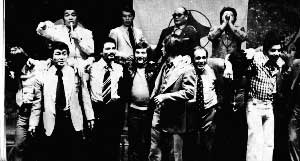
The First World Open Karate Tournament Officials :
Honourary President: King Hossein (King of Jordan)
President: Mr. Matsuhei Mori (Minister of Japan)
Vice President: Mr. Hiroyoshi Kawada (President of Nikkan Sports News-Publishing Co. Ltd.) Mr. Clarence Fong (Attorney of law)
Adviser: Mr. Eisaku Sato (Former Prime Minister of Japan) Mr. Takeo Miki (Former Vice Prime Minister of Japan) Prince Juan Carlos (Prince of Spain) Prince Shahram Pahlavi-Nia (Prince of Iran) Mr. Bedford Davie (Adviser of American Kyokushinkaikan Organization)
Chairman of the Tournament : Mr. Hideo Shiotsugu (President of K. R. C.) Mr. Hideo Okamura (Executive director of Nikkan Sports News-Publishing Co. Ltd.) Vice Chairman of the Tournament: Mr. Shigeru Horii (The chief of the planning department of Nikkan Sports News Co.Ltd.) Mr. Tadashi Nakamura (Chairman of North American Kyokushinkaikan Organization) Mr. Loek''Hollander (Chairman of European Kyokushinkaikan Organization)
Chairman of the Council of the Tournament: Mr. Ikki Kajiwara (Councilor of Kyokushinkaikan) Mr. Fumiki Okazaki (Chairman of Editorial department of Nikkan Sports News Co. Ltd)
Vice Chairman of the Council of the Tournament: Mr. Shigeru Oyama (Adviser of North American Kyokushinkaikan Organization) Mr. Tei Kurihara (Vice Chairman of Editorial Department of Nihkan Sports News Co. Ltd.)
Councilor of the Tournament: Mr. Ryuichi Inoue (Chairman of the Sports Department of Nikkan Sports News Co. Ltd.) Mr. Tomiyasu Inoue (Planning Department of Nikkan Sports News Co. Ltd.) Mr. Hiroshi Sato (Planning Department of Nikkan Sports News Co. Ltd.) Mr. Akira Kuroda (Planning Department of Nikkan Sports News Co. Ltd.) Mr. Hisao Maki CCouncilor of Kyokushihnkaikan) Mr. Ivan Zavetchanos (Chairman of South Pasific Kyokushinkaikan Organization) Mr. Peter Chong (Chairman of South-East Asia Kyokushinkaikan Organization) Mr. Nardi T. Nirwanto (Vice Chairman of South-East Asia Kyokushinkaikan Organization) Mr. Ching Chin Joe (Vice Chairman of South-East Asia Kyokushinkaikan Organization) Mr. Loek Hollander (Chairman of European Kyokushinkaikan Organization) Mr. Len Barnes (Branch-Chief in South Africa) Mr. lan Harris (Chairman of South-Africa Kyokushinkaikan Organization) Mr. Ed Bobby Lowe (Hawaii Branch Chief) Mr. Steve Arneil (Branch-Chief in England) Mr. Seiji Isobe (Chairman of South-America Kyokushinkaikan Organization) Mr. Kenichi Hashiba (Counceler of Kyokushinkaikan) Mr. Takashi Takahashi (Commissioner of Kyokushinkaikan) Mr. Toshio Fukuzawa (Commissioner of Kyokushinkaikan) Mr. Koshiro Miura (Commissioner of Kyokushinkaikan) Mr. Tetsuro Morikawa (Commissioner of Kyokushinkaikan) Mr. Tetsuo Nishijima (Commissioner of Kyokushinkaikan)
The Judges :
| Mr. Loek Hollander | Mr. Tokuro Ito | Mr. Isamu Yamashita |
| Mr. Peter Chong | Mr. Yasuhiko Oyama | Mr. Kaneo Saito |
| Mr. Noboru Takeda | Mr. Steve Arneil | Mr. Seiji Isobe |
| Mr. Hisao Kaneko | Mr. Takashi Takahashi | Mr. Toshio Fukuzawa |
| Mr. Tadashi Makabe |
To: All Athletes. From: Chief Tournament Official, Masutatsu Oyama.
Kyokushin-Karate has spread all over the world, and now has a karate membership of over 1,500.000. Kyokushin-Karate is different from other styles of karate in that we "Strike and knock down the opponent." Other styles of karate begin with basic physical exercises, Kyokushin-karate. however, begins with ."Zen". As for the tournament contestants, anyone who has confidence in his art may participate in our Open Tournament, we will heartily welcome such a competitor. Over 15.000 excited spectators attended the 5th All Japan Open Karate Tournament, last year, in the Tokyo gymnasium. The audience at our Open Tournaments have been increasing year by year. For reference: The 1st. Open Tournament-4,000 spectators. The 2nd. Open Tournament-6.000 spectators. The 3rd. Open Tournament-10,000 spectators. The 4th Open Tournament-15,000 spectators. I expect to see many, many skilled athletes participate in this year's Open Tournament. Following are the tournament rules.
Although time is limited, the head judge, after consultation with the chairman and vice-chairman of the review panel, and the assistant head judge, may allow extra time.
Kumite (Free-style practice fights)
1. One bout shall last three minutes.
2. The winner shall be awarded one full point or one half point. Fouls or disqualification on the part of one opponent automatically awards victory to the other opponent.
3. Full-point victory a. Excluding the techniques listed as fouls, a thrust, kick, elbow strike or other, techniques that connects instantaneously and Downs the opponent scores a full point. b. When an opponent says he is beaten as the result of such techniques as foot hooks, the other opponent is awarded a full point.
4. Half-point victory : a. When no definite one-point is made, the judging committee, after deliberation, will award a half-point victory on the basis of relative warnings for technical skill and fighting spirit. b. Contestants may object to the judge's decision.
5. Fouls : a. Even a light touch by the hand or elbow on the opponent's face means disqualification. Contestants may screen their faces as they see fit. b. Groin kicks. c. Head thrust. d. Attacks to the face and neck with spear hand. e. Striking or kicking an opponent who is already down. f. More than three warnings constitute a disqualification. g. Any other techniques or practices that the judge may regard as foul or unfair.
6. Warnings : a. Holding the opponent for more than one seconds. In certain cases, this will be left to the discretion of the head judge. b. Frequent retreating from the contest ring. This, too, is subject to the decision of the head judge. c. Warnings shall be given when the head judge considers any contestant' s attitude especially bad. d. A competitor must not grasp the opponent s uniform. If the referee regards it as a foul the competitor will be penalized.
7. Disqualification : a. Anyone who fails to obey the judge' s instruction during a bout shall be disqualified. b. Contestants who are late for bouts or those who fail to appear shall be disqualified. c. Contestants who fail to engage in Kumite for more than three minutes shall be disqualified. d. Violence or a bad attitude shall result in disqualification. e. Physical disability arising during the tournament, after examination by the tournament physician. f. Misfortune to anyone closely related to the contestant excuses that contestant from participating. Permission to leave will be granted after consultation with the head judge, the chairman of the
Tameshiwari
1. The judges and deliberative comm ittee shall examine mate rials used for Tameshiwari. These mate rials shall be boards of cryptomeria cedar 33 cedarmeters long, 21 centimeters wide, and 24 millimeters th ick. centimeters 2. Kach contestant must break than the minimum( three) boards with tour techniques (1' forefist t2) kn ife- hand t3.' e Ihow. and '4! kn ife- foot. 3. The contestant may attempt to break as many hoard as he likes, but unless they all break no point \v 111 be a w a r d e d. 4. Joints are awarded on the basis of the number of boards broken. In the case of a tie, the lighter person will win. 5. The boa rds must he placed ac ross the top of two cone re te block s. Contestants are not a 1 lowed to move or touch the board without permission. 6. To we Is or othe r mate r ia Is may be placed on the top of the boards for pro tec tion but the contestant must have the approval of the judges. 7. The boa rd may be measured before the Tamesh iwari, but they must not he touched by the contestant. 9. The Tamesh iwar i time is set at two minutes ; the contestant will he notified th irty seconds before the time is over. Overtimes mean disqualifications. 9. As a rule. anyone d is qua I i tied in the Tamesh iwar i may not appear in the Kumite, On ly Kumite winners may continue in the Fa mesh iwar i tr ia Is.
INFORMATION FOR THE ATHLETES
1. Application for entry in the tournament must he submitted to the office of the tournament headquarters All applications must arrive at that office no later than February 8 1975 Should the number of applications exceed the tournament participation limit, the judging panel of the Kyokushinkaikan in the presence of representives from a newspapei company will make the selection
2. No application will be accepted unless it is accompanied by a letter of recommendation ft om a Branch Chief or Karate Master A medical examination and mitten permission (by a qualified physician is required for each contestant, to participate in the tournament
3. hach application must be accompanied by a 3,000 fee and two recent photographs of the applicant. A participation fee of 15,000 must be submitted in exchange for a contestant number and permission to take part in the tournament. A coach or a responsible person representing the athlete, must pay this total fee at the time of registration
4. Each contestant must provide a clean uniform of the kind specified. This uniform is to bear absoluteiy no marking other than the contestant's number
5. Each contestant must attach the number sent from the tournament headquarters to the hack of his unifoirn
6. Fingernails must be cut short, and nothing may be held in or worn on hands or feet
7. Contestants must gather at the tournament site by 9 ' 00 before noon on March 8 1975 {Saturday)
8. All contestants must be punctual and obey the instruction of the persons in charge of the proceedings
9. This organization is not responsible for injuries or accidents that occur during the tournament
10. The tournament mil be fought by individuals (no weight limit), team fighting is excluded
11. Each athlete is expected to stay at the hotel assigned to him
